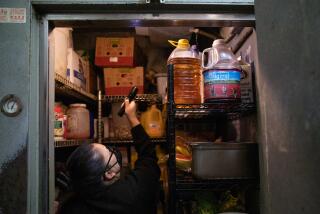What’s Behind Those Ship Sanitation Scores
- Share via
About 5 million North American travelers are expected to cruise this year, up from 4.4 million last year, according to Cruise Lines International Assn., a New York-based trade organization.
Before booking, many travelers research ship sanitation scores--ratings bestowed on individual craft by officials of the federal Centers for Disease Control and Prevention through their Vessel Sanitation Program. The travelers then select their cruise, perhaps in part influenced by sanitation track records. A score of 86 or higher is considered passing by CDC, which administers the voluntary program.
What travelers won’t glean from a quick glance at the scores, distributed via travel agents, the Internet and the CDC: The percentage of cruise ships passing inspection on the first try has been declining.
From January through June, 1997, about 84% of ships passed on the first inspection, said Gail Hayes, a CDC spokeswoman. But in 1996, that figure was about 93%, according to David Forney of the CDC’s Vessel Sanitation Program.
The good news: The overwhelming majority of ships pass on second inspection, according to Forney. And so far, the declining scores don’t constitute a public health hazard, according to the CDC.
Whether this year’s downturn in scores is due to declining standards or simply a cyclical blip is a matter of debate, with cruise line officials suggesting that it is a variation that will even out by year’s end.
While that debate continues, here’s information travelers should know:
The government inspection program, described by the CDC as “a cooperative activity with the cruise ship industry,” was established in 1975, following several major disease outbreaks on cruise vessels. In the long term, conditions on board ships actually have improved, according to CDC. For example, the number of diarrheal outbreaks has decreased from about 15 per year in the ‘70s to about five this year.
In all, 111 ships participate in the program, according to Hayes. Of those, 64 sail regularly, 25 seasonally and 22 occasionally.
Every vessel with a foreign itinerary that carries 13 or more passengers and docks at ports under U.S. control (U.S. cities or territories), is subject to twice yearly unannounced inspections and, when necessary, reinspections.
To date, none of the program participants--a group that includes all of the major cruise lines--has refused inspection. (Ships sailing in Hawaii between U.S. ports are inspected by Hawaii state health officials and the Food and Drug Administration. Results of those inspections are available from the Hawaii Department of Health, Sanitation branch, 591 Ala Moana Blvd., Honolulu 96813.)
CDC inspections are conducted at ports under U.S. control and cover such aspects as water supply and storage and distribution and disinfection of water.
Also examined: food preparation techniques, food storage and temperature of stored foods. Inspectors also look for potential contamination of food, water or ice. They examine personal hygiene of employees and determine if standards for general cleanliness, pest control and facility repair are being met. The score drops with each infraction.
A score of 86 or higher, according to the CDC, “indicates that the ship is providing an accepted standard of sanitation.” While lower scores generally reflect lower sanitation levels, the CDC states that a low score “does not necessarily imply an imminent risk of an outbreak of gastrointestinal disease or other illness related to environmental sanitation.”
If a ship does not pass, its operators file a corrective action plan. Then a reinspection is conducted.
Should a health hazard seem imminent--food maintained at an unsafe temperature, for example, or the presence of a communicable disease--the CDC inspector can recommend a ship not sail. (This rarely happens.)
Cooperation in the program is voluntary and cruise lines participate at their own expense. All inspection costs are paid for by the cruise lines, as are costs of any necessary repairs or employee training.
“It costs us $25,000 to $30,000 a year” to participate in the sanitation program, said John Dalton, spokesman for Clipper Cruise Lines, which operates the Nantucket and Yorktown Clipper. Inspection fees vary but Clipper’s are about $1,100 per ship, per inspection.
The sheer size of some ships, carrying up to 3,000 passengers in some cases, can make keeping everything shipshape a challenge. “If you come on a ship, you are always going to find something not right,” said Clipper Cruise Lines’ Dalton. In fact, few ships score 100 on inspections.
For more information: The Summary of Sanitation Inspections of International Cruise Ships (called the “green sheet”) is published every two weeks. The sheet is distributed to travel related services and is on the CDC’s Internet home page at www.cdc.gov . It also is available through the CDC fax service. Call (404) 332-4565 and request document No. 510051. For copies of the complete inspection for a specific ship, write: Vessel Sanitation Program, Center of Environmental Health, CDC, 1015 North American Way, Room 107, Miami, FL 33132.
The Healthy Traveler appears the second and fourth week of every month.
More to Read
Sign up for The Wild
We’ll help you find the best places to hike, bike and run, as well as the perfect silent spots for meditation and yoga.
You may occasionally receive promotional content from the Los Angeles Times.






